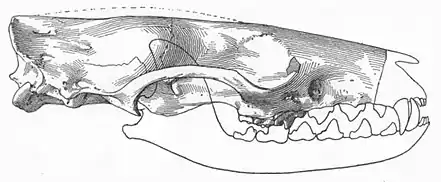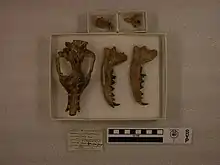| Viverravidae | |
|---|---|
 | |
| skull of Viverravus minutus | |
 | |
| skull of Didymictis protenus | |
| Scientific classification | |
| Domain: | Eukaryota |
| Kingdom: | Animalia |
| Phylum: | Chordata |
| Class: | Mammalia |
| Clade: | Pan-Carnivora |
| Clade: | Carnivoramorpha |
| Superfamily: | †Viverravoidea Wortman & Matthew, 1899 |
| Family: | †Viverravidae Wortman & Matthew, 1899[1] |
| Type genus | |
| †Viverravus Marsh, 1872 | |
| Genera | |
|
[see classification] | |
| Synonyms | |
Viverravidae ("ancestors of viverrids") is an extinct monophyletic family of mammals from extinct superfamily Viverravoidea within the clade Carnivoramorpha, that lived from the early Palaeocene to the late Eocene in North America, Europe and Asia.[5][6][7] They were once thought to be the earliest carnivorans and ancestral to extant ones, but now are placed outside the order Carnivora based on cranial morphology as relatives (a plesion-group) to extant carnivorans.[8][9]
General characteristics
Wang and Tedford propose that they arose in North America 66-60 million years ago, spread to Asia then later to Europe, and were the first carnivoramorphans and possessed the first true pair of carnassial teeth.[10] In viverravids, the skull is elongated and the number of molars is reduced to two (M1/m1 and M2/m2 are present and M3/m3 are absent).
Classification and phylogeny
Classification
Taxonomy retrieved from the Paleobiology Database[11]
| Superfamily: †Viverravoidea (Wortman & Matthew, 1899) Family: †Viverravidae (Wortman & Matthew, 1899)
|
Phylogeny
The phylogenetic relationships of family Viverravidae are shown in the following cladogram:[3][12][13][14][15]
| Carnivoramorpha |
| ||||||||||||||||||||||||||||||||||||||||||||||||||||||||||||||||||||||||||||||||||||||||||||||||||||||||||||||||||||||||||||||||||||||||||||||||||||||||||||||||||||||||||||||||||||||||||||||||||||||||||||||||||||||||||||||||||||||||||||||||
See also
References
- ↑ Wortman, J. L.; Matthew, W. D. (1899). "The ancestry of certain members of the Canidae, Viverridae, and Procyonidae". Bulletin of the American Museum of Natural History. 12: 109–138. hdl:2246/1535. OCLC 46687698.
- ↑ Miklos Kretzoi (1945) "Bemerkungen über das Raubtiersystem." Annales Historico-Naturales Musei Nationalis Hungarici, Budapest, vol. 38, pp. 59-83.
- 1 2 J. J. Flynn and H. Galiano. (1982.) "Phylogeny of Early Tertiary Carnivora, With a Description of a New Species of Protictis From the Middle Eocene of Northwestern Wyoming" American Museum Novitates 2725:1-64
- ↑ W. D. Matthew (1909) "The Carnivora and Insectivora of the Bridger Basin, middle Eocene." Memoirs of the American Museum of Natural History 9:289-567
- ↑ "†family Viverravidae (Wortman & Matthew, 1899) (placental)". Fossilworks. Retrieved 29 June 2019 from the Paleobiology Database.
{{cite web}}: CS1 maint: postscript (link) - ↑ Malcolm C. McKenna, Susan K. Bell: Classification of Mammals: Above the Species Level in Columbia University Press, New York (1997), 631 Seiten. Viverravidae
- ↑ Zack, Shawn P. (2012). "Deciduous dentition of Didymictis (Carnivoramorpha: Viverravidae): implications for the first appearance of "Creodonta"". Journal of Mammalogy. 93 (3): 808–817. doi:10.1644/11-MAMM-A-245.1. ISSN 0022-2372.
- ↑ Wesley-Hunt, G. D.; Flynn, J. J. (2005). "Phylogeny of the Carnivora: basal relationships among the carnivoramorphans, and assessment of the position of 'Miacoidea' relative to Carnivora". Journal of Systematic Palaeontology. 3: 1–28. doi:10.1017/S1477201904001518. S2CID 86755875.
- ↑ Polly, David, Gina D. Wesley-Hunt, Ronald E. Heinrich, Graham Davis and Peter Houde (2006). "Earliest known carnivoran auditory bulla and support for a recent origin of crown-clade carnivora (Eutheria, Mammalia)" (PDF). Palaeontology. 49 (5): 1019–1027. doi:10.1111/j.1475-4983.2006.00586.x.
{{cite journal}}: CS1 maint: multiple names: authors list (link) - ↑ Wang, Xiaoming; Tedford, Richard H. (2008.) "Dogs: Their Fossil Relatives and Evolutionary History." New York: Columbia University Press
- ↑ Paleobiology Database. Retrieved with Fossilworks (March 3, 2017)
- ↑ P. D. Gingerich and D. A. Winkler. (1985.) "Systematics of Paleocene Viverravidae (Mammalia, Carnivora) in the Bighorn Basin and Clark's Fork Basin, Wyoming." Contributions from the Museum of Paleontology, University of Michigan 27(4):87-128
- ↑ P. D. Polly. (1997.) "Ancestry and Species Definition in Paleontology: A Stratocladistic Analysis of Paleocene-Eocene Viverravidae (Mammalia, Carnivora) from Wyoming." Contributions from the Museum of Paleontology, University of Michigan 30(1):1-53
- ↑ Solé, Floréal; Smith, Thierry; De Bast, Eric; Codrea, Vlad; Gheerbrant, Emmanuel (2016). "New carnivoraforms from the latest Paleocene of Europe and their bearing on the origin and radiation of Carnivoraformes (Carnivoramorpha, Mammalia)". Journal of Vertebrate Paleontology. 36 (2): e1082480. doi:10.1080/02724634.2016.1082480. ISSN 0272-4634. S2CID 87537565.
- ↑ S. Faurby, L. Werdelin, A. Antonelli (2019.) "Dispersal ability predicts evolutionary success among mammalian carnivores" Department of Biological and Environmental Sciences, University of Gothenburg, Box 461, SE